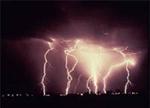
Wildland
Fires: Causes
In
the United States, about 2.5 million acres (one acre = a football field,
approximately) of developed lands and wildlands burn every year. Often
the carelessness of people leads to fires in wildlands. Some wildland
fires are caused by campers who neglect to properly extinguish campfires.
Other wildland fires result from lit cigarettes tossed onto the dry ground.
 The
majority of wildland fires in the
world are thought to be started by people. However, the greatest cause
of wildland fires is lightning. Eight million lightning strikes occur
worldwide each day. One percent of these strikes results in wildland fires.
In fact, dry lightning is responsible for 80 percent of all fires in wildland
areas. Dry lightning occurs during thunderstorms when the humidity
is so low (the air is so dry) that rain evaporates
before it reaches the ground. Even though the rain does not reach the
ground, the lightning does. Photo:
Lightning over Norman, OK, March 1978 by C. Clark. Courtesy of NOAA
Photo Library, NOAA Central Library.
The
majority of wildland fires in the
world are thought to be started by people. However, the greatest cause
of wildland fires is lightning. Eight million lightning strikes occur
worldwide each day. One percent of these strikes results in wildland fires.
In fact, dry lightning is responsible for 80 percent of all fires in wildland
areas. Dry lightning occurs during thunderstorms when the humidity
is so low (the air is so dry) that rain evaporates
before it reaches the ground. Even though the rain does not reach the
ground, the lightning does. Photo:
Lightning over Norman, OK, March 1978 by C. Clark. Courtesy of NOAA
Photo Library, NOAA Central Library.
How do thunderstorms form? They start with the formation of a storm cloud. When moisture-laden warm air is heated, it begins to rise. Air, like water, moving in one direction is called a "current." As warm, moist air currents rise in the atmosphere, the surrounding air pressure and temperature decrease. The air in the current then expands. This causes it to cool. As it cools, the moisture (water vapor) in the air condenses to form water droplets. The water droplets gather near each other to form a cloud. As the air in the cloud continues to cool, more moisture condenses. The water droplets making up the cloud grow and join together. Eventually, some of the water droplets become so large and heavy that the air currents within the cloud can no longer support them. These water droplets then fall from the cloud as rain (or snow or sleet, depending on the temperature).
Negatively charged molecules of air accumulate near the base of storm clouds. The negative charge in a storm cloud is attracted to the positive charge on the ground. This attraction causes energy to build up between a storm cloud and the ground. When a large amount of energy builds up, a spark leaves the cloud and heads toward the ground. The negatively charged molecules in the cloud streak behind the spark. This discharge of energy is the lightning seen in the sky.
Lightning strikes the earth almost all the time. In 1989, the Lightning Detection Network began recording lightning strikes over the 48 continental United States. Since then, the network has recorded an average of 20,000,000 cloud-to-ground flashes each year. About half of all flashes have more than one ground strike point. Therefore, at least 30 million points on the ground in the continental United States are struck each year.
Lightning temperatures can be very hot, sometimes over 50,000 [degrees] F. This tremendous heat provides the third element of the fire triangle discussed in the Fire Science puzzle piece. That is why a fire frequently ignites when lightning strikes fuel.
When lightning strikes the ground, it can ignite the grass. Once a fire is ignited, conditions such as dry air and dry vegetation, as well as high winds, can cause the fire to spread. Flames from a large wildland fire can reach as high as 300 feet. Nearby fuel such as low hanging tree branches or thin-barked trees can quickly catch fire. This can lead to large scale fires in which even trees like the Douglas fir that often survives smaller fires can burn.
Causes
..|..
Effects
.
Glossary
|
Related Links
|
References
|
PBL Model
HTML code by Chris
Kreger
Maintained by ETE
Team
Last updated April 28, 2005
Some images © 2004 www.clipart.com
Privacy Statement and Copyright © 1997-2004 by Wheeling Jesuit University/NASA-supported Classroom of the Future. All rights reserved.
Center for Educational Technologies, Circuit Board/Apple graphic logo, and COTF Classroom of the Future logo are registered trademarks of Wheeling Jesuit University.
